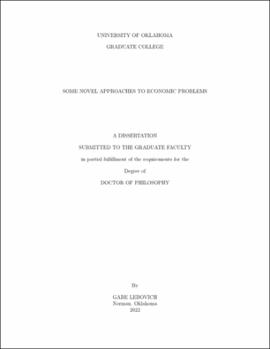| dc.contributor.advisor | Hartigan, James | |
| dc.contributor.author | Lebovich, Gabe | |
| dc.date.accessioned | 2022-05-10T18:54:54Z | |
| dc.date.available | 2022-05-10T18:54:54Z | |
| dc.date.issued | 2022-05-13 | |
| dc.identifier.uri | https://hdl.handle.net/11244/335672 | |
| dc.description.abstract | In chapter 1, I investigate the role of social connections in the formation of political coalitions utilizing the county-to-county Social Connectedness Index (SCI) from Facebook. Using a generalized fixed effects model I estimate the impact of the SCI-weighted network vote margin on focal county vote margins. Democrat-leaning counties (above-median Democrat-net-Republican percentage) respond robustly to the influence of their social network in all years examined. Republican-leaning counties accelerated coalition formation in years after the 2012 election. Since voting for the US president happens at the same time in all counties, I also use a 2SLS analysis to deal with the endogeneity that stems from this simultaneous action. I construct the instrument for the endogenous network-wide vote margin variable by utilizing the network structure of the dataset. The empirical analysis in this paper confirms a high and growing level of political polarization in the US.
Chapter 2 creates a new measure of social capital that combines bridging and bonding social capital. New data from the Facebook user network makes this possible. I use the new measure to reassess the role of social capital on a variety of outcomes previously studied in the literature. I use the network topology of social connections and within-county associational membership levels to measure county-level social capital. This measure allows one to combine two different types of measures into a comprehensive one. Since bonding and bridging social capital are by nature different, the ability to measure these two values from different sources and then combine them improves my measure of social capital over previous ones. Results show that my measure is a superior predictor of a variety of social and economic outcomes.
Chapter 3 is coauthored with Cheng Ma. In chapter 3, we test the effect of additional children in a family on health and educational outcomes. Estimating this effect is complicated by the endogeneity of family size. We use the variation in the severity of the effect of the one-child-policy in China to extract exogenous variation from the China Health and Nutrition Survey in the same country. After finding a negative effect of family size on health and educational outcomes of children we use a newly developed machine learning approach. Generalized random forests allows us to look at the heterogeneity in treatment effects in the quantity-quality trade-off. We find robust negative treatment effects of additional children on health outcomes but only mild effects on educational attainment. The machine learning algorithm finds mother's age and parent's education level play a large role in the negative quantity-quality trade-off. Pinpointing the factors that exacerbate the negative effect of additional children on child quality can aid future policy decisions. | en_US |
| dc.language | en | en_US |
| dc.rights | Attribution-NonCommercial-NoDerivatives 4.0 International | * |
| dc.rights.uri | https://creativecommons.org/licenses/by-nc-nd/4.0/ | * |
| dc.subject | quantity quality trade-off | en_US |
| dc.subject | Social networks | en_US |
| dc.subject | social capital | en_US |
| dc.title | Some novel approaches to economic problems | en_US |
| dc.contributor.committeeMember | Ransom, Tyler | |
| dc.contributor.committeeMember | Wang, Chunbei | |
| dc.contributor.committeeMember | Haltman, Kenneth | |
| dc.date.manuscript | 2022-04-22 | |
| dc.thesis.degree | Ph.D. | en_US |
| ou.group | Dodge Family College of Arts and Sciences::Department of Economics | en_US |

